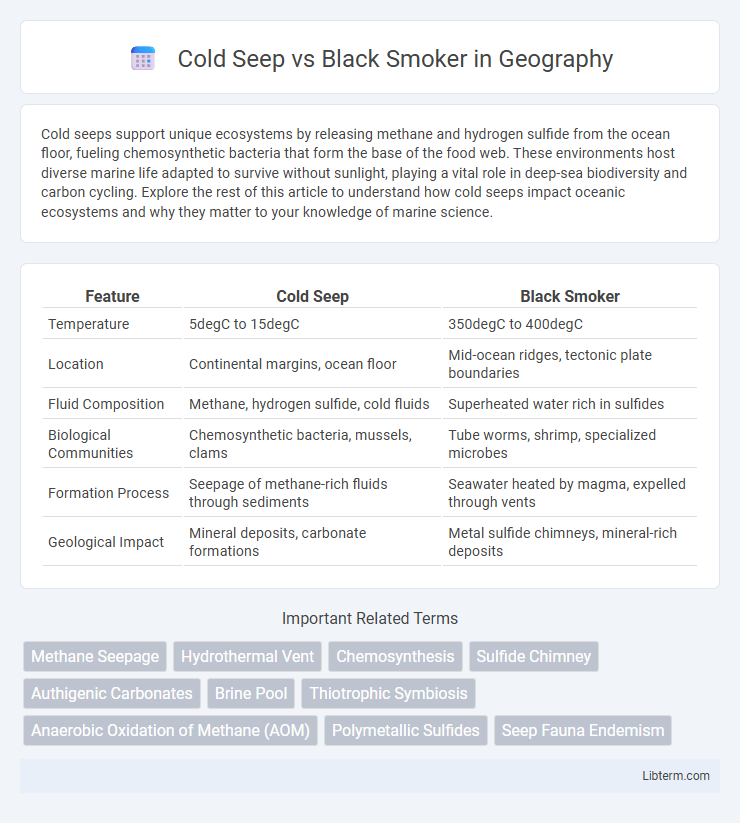Cold seeps support unique ecosystems by releasing methane and hydrogen sulfide from the ocean floor, fueling chemosynthetic bacteria that form the base of the food web. These environments host diverse marine life adapted to survive without sunlight, playing a vital role in deep-sea biodiversity and carbon cycling. Explore the rest of this article to understand how cold seeps impact oceanic ecosystems and why they matter to your knowledge of marine science.
Table of Comparison
| Feature | Cold Seep | Black Smoker |
|---|---|---|
| Temperature | 5degC to 15degC | 350degC to 400degC |
| Location | Continental margins, ocean floor | Mid-ocean ridges, tectonic plate boundaries |
| Fluid Composition | Methane, hydrogen sulfide, cold fluids | Superheated water rich in sulfides |
| Biological Communities | Chemosynthetic bacteria, mussels, clams | Tube worms, shrimp, specialized microbes |
| Formation Process | Seepage of methane-rich fluids through sediments | Seawater heated by magma, expelled through vents |
| Geological Impact | Mineral deposits, carbonate formations | Metal sulfide chimneys, mineral-rich deposits |
Introduction: Understanding Cold Seeps and Black Smokers
Cold seeps and black smokers are unique deep-sea hydrothermal ecosystems characterized by distinct chemical and thermal properties. Cold seeps emit methane-rich fluids at ambient seafloor temperatures, supporting chemosynthetic communities reliant on methane oxidation. Black smokers release superheated, mineral-laden fluids over 350degC, creating hydrothermal vents that sustain diverse metal-oxidizing microorganisms and complex biological assemblages.
Geological Formation Processes
Cold seeps form through the slow escape of hydrocarbons and methane-rich fluids from subsurface sediments, typically on continental margins where organic-rich sediments undergo diagenesis. Black smokers result from seawater percolating through oceanic crust near mid-ocean ridges, becoming superheated by underlying magma before discharging metal-rich, mineral-laden fluids. Both geological formations are driven by tectonic activity but differ primarily in fluid temperature and chemical composition, influencing distinct ecosystems and mineral deposits.
Physical and Chemical Characteristics
Cold seeps occur at low temperatures, typically below 10degC, and release methane-rich fluids that form carbonate rock structures, whereas black smokers emit superheated water reaching up to 400degC, rich in metal sulfides such as iron and copper. Cold seep fluids are chemically reducing, dominated by methane and hydrogen sulfide, promoting unique chemosynthetic communities, while black smokers discharge highly acidic and metal-laden fluids due to hydrothermal venting processes. The mineral deposits at cold seeps mainly consist of carbonates, contrasting with the sulfide chimneys and metal ore precipitates formed by black smoker activity.
Depth and Location in the Ocean
Cold seeps typically form at depths ranging from 500 to 3,000 meters along continental margins, where methane-rich fluids escape from the seabed. Black smokers are found deeper, often between 2,000 and 4,000 meters near mid-ocean ridges, where superheated mineral-laden water is expelled from hydrothermal vents. The distinct depth and tectonic settings influence the unique chemical environments and biological communities of cold seeps and black smokers.
Unique Ecosystem and Biodiversity
Cold seeps host ecosystems characterized by chemosynthetic communities that rely on methane and hydrogen sulfide, supporting organisms like clams, mussels, and tube worms adapted to low-temperature, nutrient-rich environments. Black smokers emit superheated, mineral-laden fluids fostering unique biological assemblages dominated by thermophilic archaea, bacteria, and specialized fauna such as giant tube worms and vent crabs. The contrast in temperature and chemical composition drives distinct biodiversity patterns and ecological niches between cold seep and black smoker habitats.
Key Differences in Energy Sources
Cold seeps rely on the chemical energy from hydrocarbons like methane and hydrogen sulfide seeping from seabed sediments, supporting chemosynthetic bacteria that form the base of these ecosystems. Black smokers, also known as hydrothermal vents, emit superheated, mineral-rich fluids primarily containing hydrogen sulfide, driving unique thermophilic microbial communities through the oxidation of sulfides. The fundamental energy source difference lies in cold seeps' reliance on seepage of cold hydrocarbons from sediment, while black smokers depend on high-temperature hydrothermal fluids from volcanic activity.
Notable Species at Cold Seeps vs. Black Smokers
Notable species at cold seeps include chemosynthetic clams, tubeworms, and methane-oxidizing bacteria that thrive on hydrocarbons and sulfides emitted from the ocean floor. In contrast, black smokers host extremophiles such as giant Riftia tubeworms, thermophilic bacteria, and vent crabs that depend on sulfide-rich superheated water from hydrothermal vents. Both ecosystems support unique communities fueled by chemosynthesis, but species diversity and adaptations differ due to the distinct chemical and thermal conditions.
Role in Global Biogeochemical Cycles
Cold seeps and black smokers both play crucial roles in global biogeochemical cycles by facilitating the transfer of elements such as carbon, sulfur, and methane between the Earth's crust, oceans, and biosphere. Cold seeps contribute to the carbon cycle through the anaerobic oxidation of methane, supporting unique chemosynthetic communities that impact methane flux and ocean chemistry. Black smokers drive hydrothermal circulation that releases sulfur, metals, and heat, influencing ocean chemistry and sustaining chemosynthetic ecosystems critical for nutrient cycling and deep-sea biodiversity.
Research Significance and Discoveries
Cold seeps and black smokers represent key hydrothermal and chemoautotrophic ecosystems, offering unique insights into deep-sea biology and geochemistry. Research on cold seeps has unveiled methane-rich habitats supporting specialized microbial communities and diverse fauna, crucial for understanding carbon cycling and climate impact. Studies on black smokers have highlighted extreme thermophilic microbes and metal sulfide deposition, advancing knowledge on mineral formation and potential applications in biotechnology and astrobiology.
Future Perspectives and Conservation Challenges
Cold seeps and black smokers represent distinct deep-sea hydrothermal ecosystems with unique biological communities, offering promising avenues for biotechnological innovations and climate change studies. Future research focuses on understanding their microbial processes, genetic diversity, and responses to ocean acidification, essential for predicting ecosystem resilience and guiding deep-sea mining regulations. Conservation challenges include habitat degradation from mineral extraction, limited baseline data, and the need for international collaboration to establish effective marine protected areas.
Cold Seep Infographic

 libterm.com
libterm.com